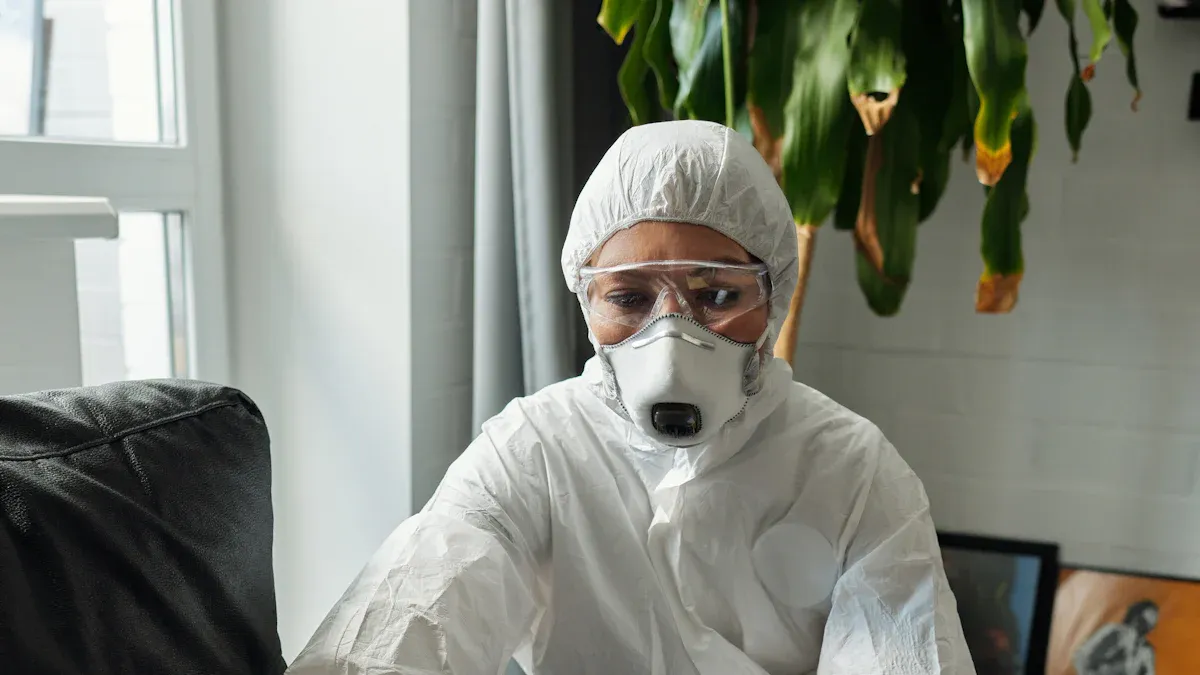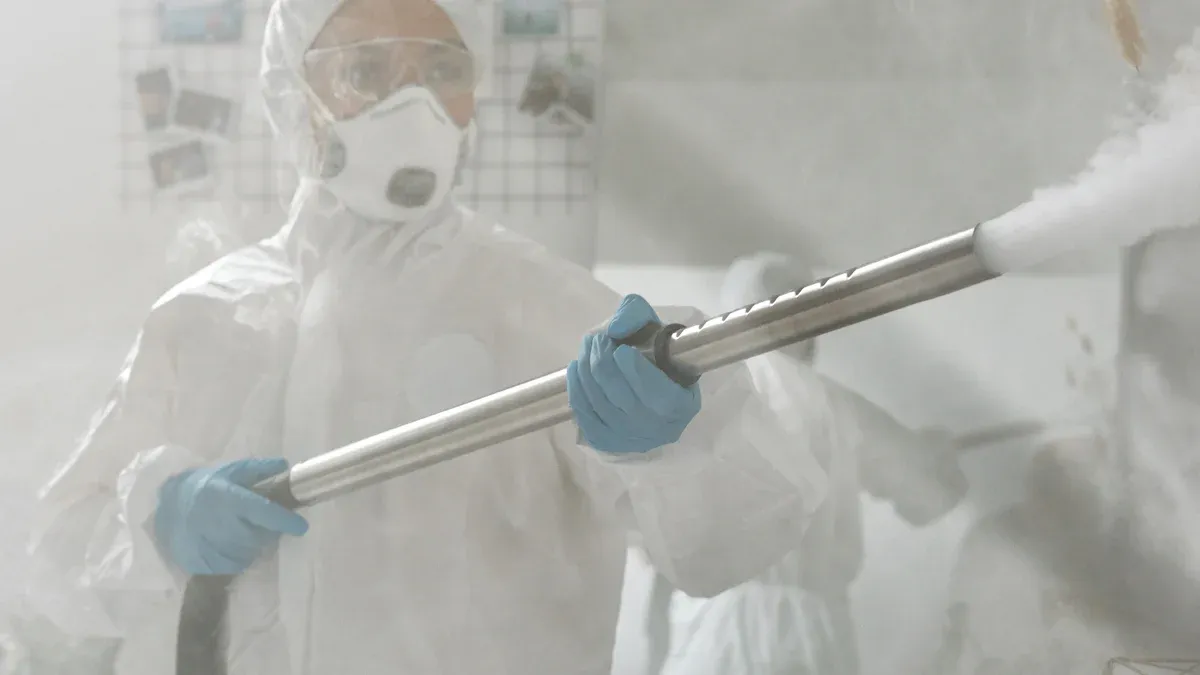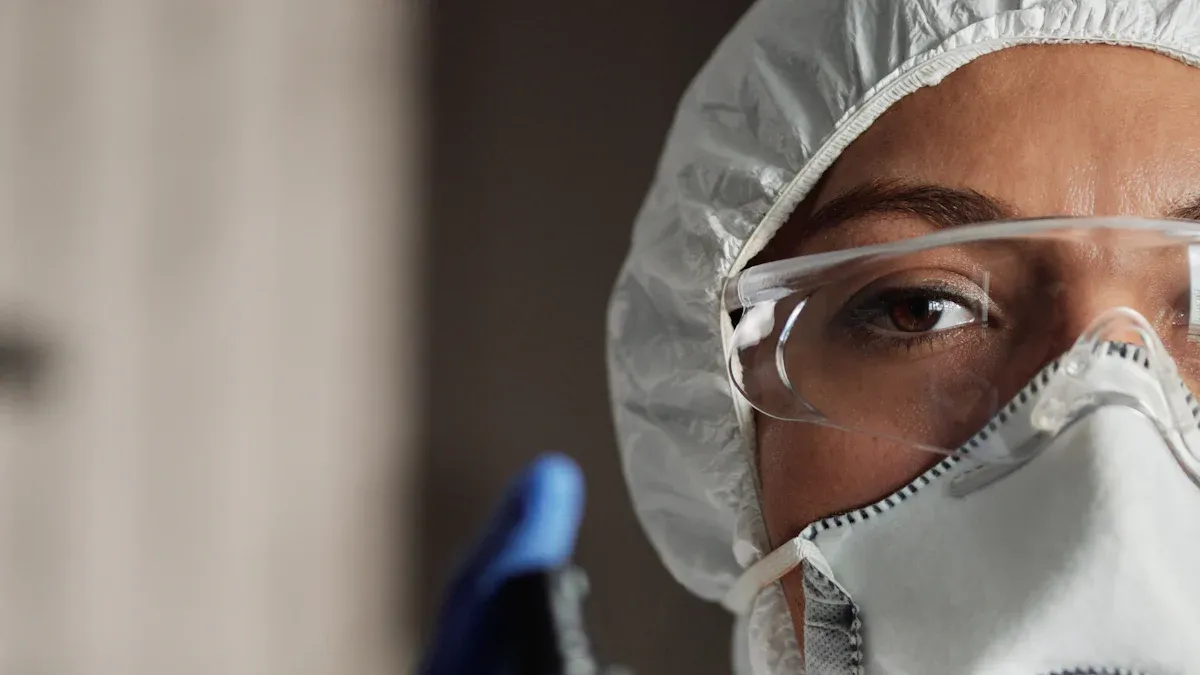PET Heat Shrink Tubing vs FEP Tubing for Medical Device Insulation

Choosing the right material for medical device encapsulation directly impacts both performance and patient safety. PET heat shrink tubing and FEP tubing offer distinct advantages for insulation needs in medical environments. PET heat shrink tube for PCB insulation in medical monitors provides excellent mechanical strength and dimensional stability. On the other hand, FEP tubing excels in chemical resistance and high-temperature tolerance. Each material's durability and biocompatibility play a critical role in ensuring reliable insulation for sensitive medical equipment.
Key Takeaways
PET shrink tubing works well for medical monitors. It is strong and affordable.
FEP tubing resists chemicals and handles heat, great for reusable devices.
Use PET tubing for tough and low-cost needs. Pick FEP tubing for tools that need cleaning often.
Both types have special advantages. Choose based on your device's needs.
FEP tubing can be customized for tricky medical uses. This boosts how well it works.
Material Properties

PET Heat Shrink Tube for PCB Insulation in Medical Monitors
PET heat shrink tubing offers exceptional mechanical strength and dimensional stability, making it a preferred choice for insulating printed circuit boards (PCBs) in medical monitors. Its ability to shrink uniformly when exposed to heat ensures a tight and secure fit around sensitive components. This characteristic is crucial for maintaining reliable electrical insulation in devices that monitor critical patient data.
The material's high tensile strength and resistance to abrasion enhance its durability, even in demanding medical environments. PET heat shrink tubing also exhibits excellent clarity, allowing for easy visual inspection of the underlying components. This transparency is particularly beneficial in medical monitors, where quick identification of potential issues can prevent device failure.
In addition to its mechanical properties, PET tubing demonstrates good chemical resistance against common cleaning agents used in medical settings. This feature ensures that the insulation remains intact during routine sterilization processes, extending the lifespan of the device. Overall, PET heat shrink tubing provides a reliable solution for PCB insulation in medical monitors, combining strength, stability, and resistance to environmental factors.
FEP Autoclavable Heat Shrink Tubing
FEP heat shrink tubing stands out for its remarkable chemical resistance and ability to withstand high temperatures. These properties make it an ideal choice for medical devices that require frequent sterilization. FEP autoclavable heat shrink tubing can endure autoclave cycles at temperatures ranging from 121°C to 135°C without losing its structural integrity or recovery properties. This resilience ensures consistent performance in reusable medical equipment.
The tubing's superior chemical resistance surpasses that of PVC and polyolefin alternatives, making it suitable for environments where exposure to harsh chemicals is common. Its biocompatibility further enhances its suitability for insulating electrical components in patient-facing applications. FEP heat shrink tubing maintains its integrity under steam sterilization, reducing the need for frequent replacements and lowering overall maintenance costs.
The following table highlights the performance metrics of FEP autoclavable heat shrink tubing:
Performance Metric | Benefit of FEP Tubing |
|---|---|
Cyclic Thermal Stress | Withstands autoclave sterilization at 121°C–135°C without delamination or loss of recovery |
Chemical Resistance | Superior resistance compared to PVC or polyolefin alternatives |
Biocompatibility | Essential for insulating electrical components in medical devices |
Structural Integrity | Maintains integrity under steam sterilization, reducing replacement costs |
Performance Issues Post-Sterilization | 40% fewer issues compared to silicone-insulated alternatives in reusable devices |
Market Growth | Projected 7.6% CAGR in minimally invasive surgical equipment correlates with FEP adoption |
FEP heat shrink tubing also offers excellent electrical insulation properties, ensuring the safety and reliability of medical devices. Its ability to resist degradation under extreme conditions makes it a trusted material for critical applications. As the demand for minimally invasive surgical equipment grows, the adoption of FEP tubing continues to rise, further solidifying its position as a leading insulation material in the medical industry.
Performance in Medical Applications

Durability and Longevity in Medical Environments
Medical devices often operate in challenging environments that demand materials with exceptional long-term durability. PET heat shrink tubing demonstrates outstanding mechanical strength, making it resistant to wear and tear caused by repeated handling or exposure to external forces. Its ability to maintain structural integrity under stress ensures reliable insulation for sensitive components over extended periods.
FEP tubing, on the other hand, excels in environments requiring frequent sterilization. Its resilience against high temperatures and harsh chemicals allows it to endure multiple autoclave cycles without compromising performance. This characteristic makes FEP tubing a preferred choice for reusable medical equipment, where durability directly impacts device longevity.
Both materials offer unique advantages in terms of durability. PET tubing is ideal for applications requiring mechanical robustness, while FEP tubing provides unmatched resistance to thermal and chemical stress. Selecting the right material depends on the specific demands of the medical device and its operating conditions.
Tip: For devices exposed to frequent sterilization, FEP tubing offers superior performance due to its ability to withstand cyclic thermal stress.
Biocompatibility and Safety for Patient-Facing Applications
Biocompatibility plays a critical role in ensuring the safety of medical devices used in patient-facing applications. PET heat shrink tubing provides reliable insulation for electrical components without compromising patient safety. Its chemical resistance minimizes the risk of contamination during routine cleaning, making it suitable for indirect contact with patients.
FEP tubing takes biocompatibility and sterilization to the next level. Its inert nature and resistance to chemical degradation make it ideal for applications involving direct patient contact. FEP tubing complies with stringent biocompatibility standards, ensuring that it does not leach harmful substances or cause adverse reactions.
Medical devices insulated with FEP tubing benefit from enhanced safety and reliability, particularly in critical applications such as surgical tools and monitoring equipment. The material’s ability to maintain performance under sterilization processes further reinforces its suitability for patient-facing devices.
Note: When biocompatibility is a top priority, FEP tubing offers a safer and more reliable solution for medical applications.
Cost and Availability
Cost Comparison Between PET and FEP Tubing
PET heat shrink tubing generally offers a cost-effective solution for medical device insulation. Its manufacturing process involves relatively lower material costs, making it an economical choice for applications requiring mechanical strength and dimensional stability. PET tubing is widely used in medical monitors and other devices where affordability is a priority.
FEP tubing, while more expensive, provides superior performance in environments requiring high-temperature tolerance and chemical resistance. The advanced properties of fluoropolymers, including FEP, contribute to its higher price point. However, its durability and ability to withstand repeated sterilization cycles often justify the investment for reusable medical equipment.
Market research indicates that the medical tubing sector is projected to grow at a compound annual growth rate (CAGR) of 8.3% from 2025 to 2030, reaching USD 18.86 billion by 2030. This growth reflects increasing demand for both PET and FEP tubing, with cost implications driven by their respective material properties and applications.
Tip: For budget-sensitive projects, PET tubing offers a practical solution. For applications requiring high performance under extreme conditions, FEP tubing provides long-term value despite its higher initial cost.
Market Availability and Customization Options
Both PET and FEP tubing are readily available in the medical market, with suppliers offering a range of sizes and specifications to meet diverse application needs. PET tubing is widely accessible due to its lower production costs and broad usage in medical monitors. FEP tubing, categorized under fluoropolymers, is a significant segment in the medical tubing market, reflecting its specialized applications and growing demand.
Customization options for FEP tubing have seen notable growth. Suppliers now offer tailored solutions, including varying diameters and wall thicknesses, to address specific requirements in medical devices. The table below highlights key trends in customization:
Evidence | Description |
|---|---|
Custom FEP Tubing | Tailored solutions for industries like pharmaceuticals and medical devices. |
Growth in Custom Solutions | Increasing demand for bespoke designs, including flexible dimensions. |
Flexibility and Compatibility | Enhanced adaptability for complex medical applications. |
FEP tubing also integrates seamlessly with smart medical devices, providing reliable insulation for sensitive components. This flexibility makes it ideal for advanced applications, such as minimally invasive surgical tools and patient-facing equipment.
Note: Customization options for FEP tubing enable the creation of innovative medical devices tailored to individual patient needs, enhancing both performance and reliability.
Use Cases and Recommendations
Best Applications for PET Heat Shrink Tubing
PET heat shrink tubing excels in applications requiring mechanical strength and dimensional stability. Its ability to provide secure insulation makes it a reliable choice for printed circuit boards (PCBs) in medical monitors. These monitors often operate in environments where durability and consistent performance are critical. PET tubing ensures that sensitive electronic components remain protected from external forces, reducing the risk of device failure.
The material's optical clarity also proves advantageous in medical devices. It allows technicians to visually inspect underlying components without removing the insulation. This feature simplifies maintenance and troubleshooting, particularly in devices that monitor patient health. Additionally, PET tubing resists abrasion and chemical exposure, making it suitable for environments where cleaning agents are frequently used.
PET tubing is an economical solution for single-use or low-maintenance medical devices. Its cost-effectiveness, combined with its robust performance, makes it a preferred choice for manufacturers aiming to balance affordability with reliability.
Best Applications for FEP Autoclavable Heat Shrink Tubing
FEP autoclavable heat shrink tubing is ideal for reusable medical devices that undergo frequent sterilization. Its ability to withstand high temperatures and harsh chemicals ensures consistent insulation performance even after multiple autoclave cycles. This makes it a top choice for surgical tools, catheters, and other patient-facing equipment.
The tubing's biocompatibility enhances its suitability for critical applications. It does not leach harmful substances, ensuring patient safety during direct contact. Its flexibility allows it to adapt to complex shapes, making it compatible with advanced medical technologies, such as minimally invasive surgical instruments.
FEP tubing also offers excellent optical clarity, enabling precise visual inspection of insulated components. This feature is particularly beneficial in devices requiring high levels of accuracy and reliability. While its initial cost is higher than PET tubing, its durability and long-term performance often offset the investment.
The table below summarizes key attributes of FEP tubing:
Attribute | FEP Tubing |
|---|---|
Flexibility | Adapts to various shapes and sizes |
Optical Clarity | Ensures visibility for inspection |
Biocompatibility | Safe for medical applications |
Cost | Higher than PVC, lower than PFA |
Durability | High, suitable for demanding uses |
Tip: For reusable medical devices exposed to extreme conditions, FEP tubing provides unmatched reliability and safety.
PET heat shrink tubing and FEP tubing each offer distinct advantages for medical device insulation. PET tubing excels in affordability and mechanical strength, making it ideal for applications like medical monitors. FEP tubing provides superior chemical resistance and biocompatibility, ensuring reliable performance in reusable and patient-facing devices.
For cost-sensitive projects, PET tubing delivers practical value. FEP tubing, however, remains the better choice for devices requiring frequent sterilization or direct patient contact. Selecting the right material ensures optimal performance and safety in medical environments, highlighting the importance of tailored solutions for specific applications.
FAQ
What is the primary difference between PET and FEP tubing?
PET tubing offers excellent mechanical strength and dimensional stability, making it ideal for medical monitors. FEP tubing, however, excels in chemical resistance and high-temperature tolerance, making it suitable for reusable medical devices requiring frequent sterilization.
Can PET and FEP tubing be used interchangeably in medical devices?
No, they serve different purposes. PET tubing works best for applications needing durability and affordability. FEP tubing is better for patient-facing or reusable devices due to its biocompatibility and resistance to harsh sterilization processes.
How does FEP tubing ensure safety in medical applications?
FEP tubing complies with stringent biocompatibility standards. It resists chemical degradation and does not leach harmful substances, ensuring safety for patient-facing medical devices like catheters and surgical tools.
Is PET tubing suitable for high-temperature environments?
PET tubing performs well in moderate conditions but lacks the high-temperature tolerance of FEP tubing. For devices exposed to autoclave sterilization or extreme heat, FEP tubing is the preferred choice.
Which tubing is more cost-effective for medical device manufacturers?
PET tubing is generally more affordable due to its lower production costs. It is ideal for single-use or low-maintenance medical devices. FEP tubing, while more expensive, offers long-term value for reusable devices requiring frequent sterilization.
See Also
Latest Innovations in FEP Heat Shrink Tubing for Healthcare
Revolutionary FEP Heat Shrink Tubing for Medical Equipment
Advantages of Using FEP Heat Shrink Tubing in Medicine
Comprehending FEP Non-Toxic Heat Shrink Tubing for Industry
Selecting Optimal FEP Biocompatible Heat Shrink Tubing for Uses

